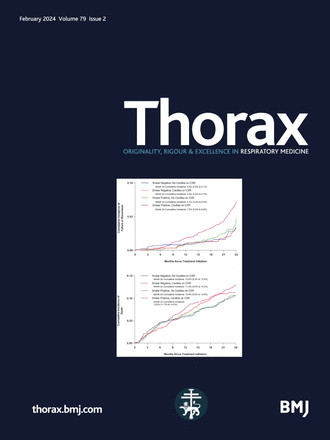Variability in forced expiratory volume in 1 s in children with symptomatically well-controlled asthma
IF 9
1区 医学
Q1 RESPIRATORY SYSTEM
引用次数: 0
Abstract
Aims Spirometry is used by many clinicians to monitor asthma in children but relatively little is understood about its variability over time. The aim of this study was to determine the variability of forced expiratory volume in 1 s (FEV1) in children with symptomatically well-controlled asthma by applying three different methods of expressing change in FEV1 over 3-month intervals. Methods Data from five longitudinal studies of children with asthma which measured FEV1 at 3-month intervals over 6 or 12 months were used. We analysed paired FEV1 measurements when asthma symptoms were controlled. The variability of FEV1% predicted (FEV1%), FEV1 z-score (FEV1z) and conditional z score for change (Zc) in FEV1 was expressed as limits of agreement. Results A total of 881 children had 3338 FEV1 measurements on occasions when asthma was controlled; 5184 pairs of FEV1 measurements made at 3-month intervals were available. Each unit change in FEV1 z score was equivalent to a Zc 1.45 and an absolute change in FEV1% of 11.6%. The limits of agreement for change in FEV1% were −20 and +21, absolute change in FEV1 z were −1.7 and +1.7 and Zc were −2.6 and +2.1. Regression to the mean and increased variability in younger children were present for change in FEV1% and FEV1z comparisons, but not Zc. Conclusion Given the wide limits of agreement of paired FEV1 measurements in symptomatically well-controlled children, asthma treatment should primarily be guided by symptoms and not by a change in spirometry. Data may be obtained from a third party and are not publicly available. Original data may be obtained by contacting the lead for each of the five study populations whose data contributed to the present analysis.症状控制良好的哮喘患儿 1 秒用力呼气量的变异性
目的 许多临床医生使用肺活量法监测儿童哮喘,但对其随时间变化的了解相对较少。本研究的目的是通过采用三种不同的方法来表示 FEV1 在 3 个月时间间隔内的变化,从而确定症状控制良好的哮喘患儿 1 秒用力呼气容积 (FEV1) 的变异性。方法 我们使用了五项哮喘患儿纵向研究的数据,这些研究在 6 个月或 12 个月内每 3 个月测量一次 FEV1。我们分析了哮喘症状得到控制时的配对 FEV1 测量值。预测 FEV1% (FEV1%)、FEV1 z 评分 (FEV1z) 和 FEV1 变化的条件 z 评分 (Zc) 的变异性以一致性限值表示。结果 共有 881 名儿童在哮喘得到控制的情况下进行了 3338 次 FEV1 测量,其中 5184 对 FEV1 测量是在 3 个月间隔内进行的。FEV1 z 评分的每个单位变化相当于 Zc 1.45,FEV1% 的绝对变化相当于 11.6%。FEV1% 变化的一致性极限为 -20 和 +21,FEV1 z 绝对变化的一致性极限为 -1.7 和 +1.7,Zc 为 -2.6 和 +2.1。在 FEV1% 和 FEV1z 的比较中,存在向平均值回归的现象,且年龄较小的儿童的变异性增加,但 Zc 则不存在。结论 鉴于在症状控制良好的儿童中,配对 FEV1 测量值的一致性范围较宽,哮喘治疗应主要以症状而非肺活量的变化为指导。数据可能来自第三方,不对外公开。原始数据可通过联系五项研究的负责人获得,他们的数据对本分析有贡献。
本文章由计算机程序翻译,如有差异,请以英文原文为准。
求助全文
约1分钟内获得全文
求助全文
来源期刊

Thorax
医学-呼吸系统
CiteScore
16.10
自引率
2.00%
发文量
197
审稿时长
1 months
期刊介绍:
Thorax stands as one of the premier respiratory medicine journals globally, featuring clinical and experimental research articles spanning respiratory medicine, pediatrics, immunology, pharmacology, pathology, and surgery. The journal's mission is to publish noteworthy advancements in scientific understanding that are poised to influence clinical practice significantly. This encompasses articles delving into basic and translational mechanisms applicable to clinical material, covering areas such as cell and molecular biology, genetics, epidemiology, and immunology.
 求助内容:
求助内容: 应助结果提醒方式:
应助结果提醒方式:


